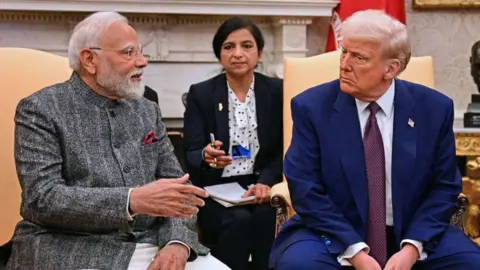In a significant move that could reshape economic ties, President Donald Trump announced that the United States will impose a 25% tariff on all goods imported from India and add an unspecified “penalty” for India’s continued trade with Russia, particularly in energy and military equipment. This announcement was made via a post on Trump’s platform, Truth Social, and is set to take effect on August 1, 2025, the deadline established for reaching a new trade agreement between the two nations.
In his remarks, Trump emphasized the need for such measures by highlighting India’s high tariffs, which he describes as some of the highest globally. He also criticized India’s purchases of Russian arms and energy, especially as the international community pressures Russia to cease hostilities in Ukraine. “India is a friend,” Trump stated, but noted that the trade practices do not reflect that friendship, signaling an aggressive shift in U.S. trade policy towards India.
The announcement comes amid ongoing negotiations between India and the U.S. for a broader trade deal, which had been in the works for several months. Last year, data indicated that the U.S. faced a substantial trade deficit of $45.8 billion with India, intensifying the urgency for a resolution to balance trade exchanges.
In the backdrop of these developments, India has yet to publicly respond to Trump’s latest announcement, raising questions about its strategy moving forward. India has been vocal about protecting its domestic industries, especially agriculture, which has remained a contentious issue in trade talks. The U.S. has continually sought greater access to India’s agricultural markets, viewing them as a vital avenue for increasing its $190 billion bilateral trade with India, a figure that both Trump and Indian Prime Minister Narendra Modi have aimed to double to $500 billion.
In prior months, Trump had proposed tariffs as high as 27% on Indian goods, though those plans were later paused amid the negotiations. This emphasis on tariff increases reflects Trump’s broader trade policy, which is characterized by a willingness to employ tariffs as a tool against nations perceived as taking advantage of U.S. trade relations. During earlier discussions, Trump characterized India as a “tariff king,” indicating his dissatisfaction with the existing trade practices.
Meanwhile, discussions have teetered between positive and cautious tones, with U.S. Trade Representative Jamieson Greer expressing the hope of reaching a constructive resolution with Indian counterparts. The ongoing trade talks have been marked by varying levels of optimism, but Greer’s comments underscore the long-standing “protectionist” stance of India’s trade policy aimed at securing domestic interests, particularly those of small farmers and commodity producers.
Agricultural policies have emerged as a major sticking point. The Indian government, under Commerce Minister Piyush Goyal, has reiterated its commitment to protect farmers’ livelihoods and emphasized that any trade agreement must ensure food security for its population. As recently as last week, Goyal expressed optimism about making “fantastic progress” toward a deal with Washington.
Although some concessions have been made, such as the reduction of tariffs on U.S. goods like Bourbon whiskey and motorcycles, the persistent trade deficit indicates challenges ahead. The U.S. imported $87.4 billion worth of goods from India in the previous year, while only exporting $41.5 billion in return.
As these changes unfold, they will undoubtedly have large-scale implications for the broader geopolitical landscape, particularly amidst a backdrop of evolving relationships between key players in the international arena. The U.S. stance towards India, compounded by its policies regarding Russia, will play a pivotal role in shaping the economic futures of both nations.












